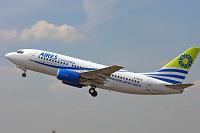Colombia's fast growing domestic market is poised for yet another year of major changes as LAN prepares a business plan for its two new Colombian subsidiaries and the former chief of Avianca re-emerges with a high profile low-cost carrier launch.
LAN in late November completed its acquisition of Aires, Colombia's second largest domestic operator which has seen its traffic grow by over 300% since bringing Colombia its first taste of low fares in early 2009. While Aires' foray into the low-cost carrier sector was hugely successful from a market share standpoint (see chart) the carrier had huge operational problems and was about to run out of cash prior to LAN's rescue. LAN ended up paying only $12 million after one month of due diligence drove down the price from an original estimate of $32.5 million.
Since the deal closedAires has increased fares, improved reliability and cut almost its entire international network. More changes are likely by March as LAN is now conducting a more detailed audit of Aires and working on a new business plan for the carrier.
At the same time LAN is also working on a plan for proposed start-up AerOasis, which is in the final stages of securing an operating certificate. LAN holds an option to buy AerOasis as part of deal it forged last spring which included helping the carrier with the start-up process and sourcing aircraft. After LAN unveiled its intention to buy Aires it seemed unlikely it would move forward with its intention of exercising this option, leaving AerOasis as a potential new independent carrier competing in the domestic market. But now all indications are both AerOasis and Aires will be merged under LAN.
 |
|---|
While all three carriers are refusing to divulge details until LAN unveils its plan for Aires and AerOasis, expected in late February or early March, sources say LAN will end up owning both operating certificates. The around 150 employees already hired by AerOasis, including pilots which temporarily flying for LAN in other countries, will work for the new LAN entity alongside ex-Aires crew and staff. Aires' nine Boeing 737-700s are expected to eventually be replaced by A320 family aircraft - the narrowbody type used exclusively by LAN and selected by AerOasis. A premium cabin is also likely to be introduced, following LAN's typical short-haul model rather than the pure low-cost approach that had been adopted by Aires.
This will temporarily leave Colombia without a low-cost player to the delight of ex-Avianca chief executive Juan Emilio Posada, who has been working along with three other co-founders on starting a new yet to be named low-cost airline. "Through the acquisition of Aires by LAN, Aires will most likely be a LAN type of carrier which leaves us a clear path to really develop the only true low cost carrier in the country," Posada says.
 |
|---|
Avianca and Copa to benefit |
|---|
Avianca and the country's other major domestic carrier, Copa Colombia, also stand to benefit from LAN's acquisition of Aires. After the initial LAN-Aires deal was inked Avianca chief executive Fabio Villegas and Copa chief executive Pedro Heilbron both said the prospect of competing against LAN instead of Aires was much more appealing. While Aires' entrance on domestic trunk routes stimulated overall demand, driving up total Colombian domestic traffic by 22% in 2009 and another 34% through the first 10 months of 2010, average fares dropped by about 30%.
"At the end it is better to have LAN in the position of Aires rather than LAN plus Aires at the same time," Villegas says. "LAN is a great airline and it usually has been a very good and fair competitor." Heilbron agrees, saying "it's better to have two competitors than three" and as a publicly traded company LAN is more likely to focus on the bottom line. "I don't see them discounting as deeply as Aires," Heilbron says.
LAN's acquisition of Aires also leaves Copa Colombia, previously known as Aero Republica, as the clear second carrier in Colombia's international market. Aires in January dropped five of its six international routes, leaving only Bogota-Fort Lauderdale. Copa Colombia has over the last year been focusing expansion on the more profitable international market. In the fourth quarter of 2010 it launched services to Cancun, Havana and Mexico City, giving Copa six international destinations from Bogota.
Prior to the LAN deal Aires was fighting with Copa Colombia over traffic rights to become the second Colombian carrier alongside Avianca on such routes as Bogota-Sao Paulo. Copa Colombia for now has a clear path to expand internationally although LAN is expected to ultimately re-look at the Colombian international market.
The biggest barrier to more growth in Colombia could be congestion at Bogota airport. The government has now finalised a long overdue deal with concession holder OPAIN to remode the existing international terminal and to construct 25,000m2 of new space to be added in 2014. But some say the expansion is not bold enough, noting only a few gates will be added. A new low-cost terminal, initially endorsed by Aires and now supported by Posada's new carrier, could be a potential solution.
Find out more about the dynamic market activity among Colombia's carriers here
Source: Airline Business



















